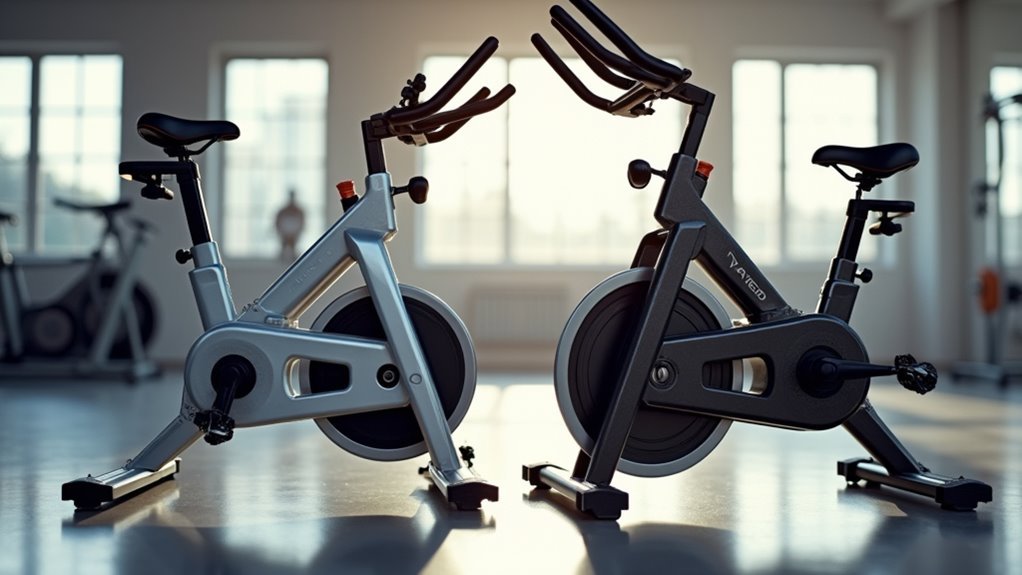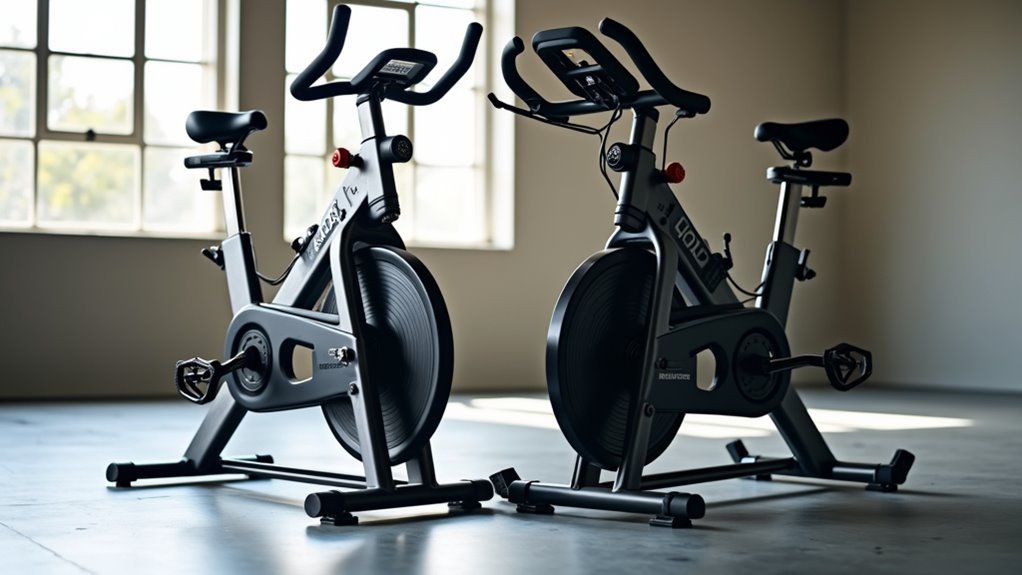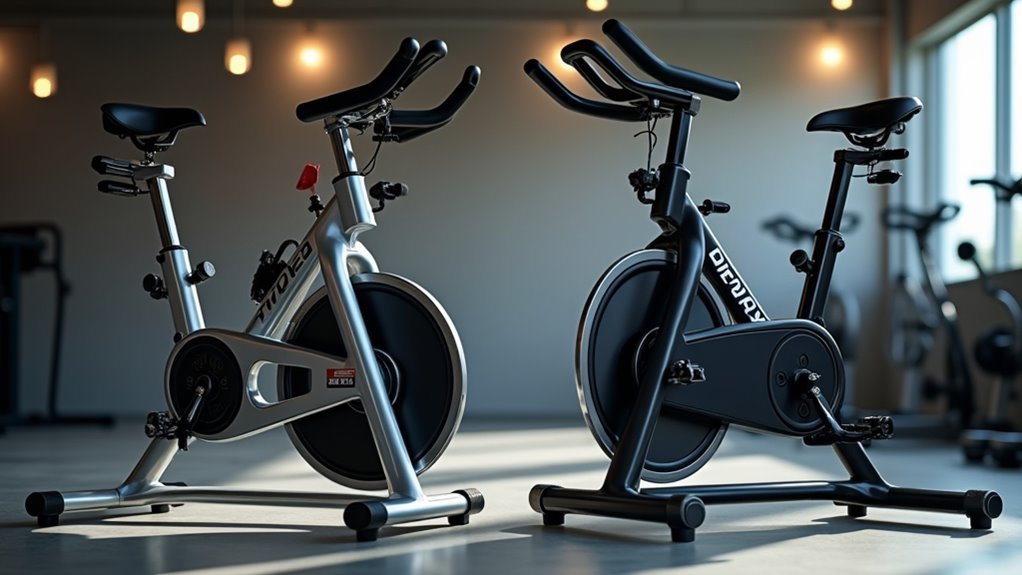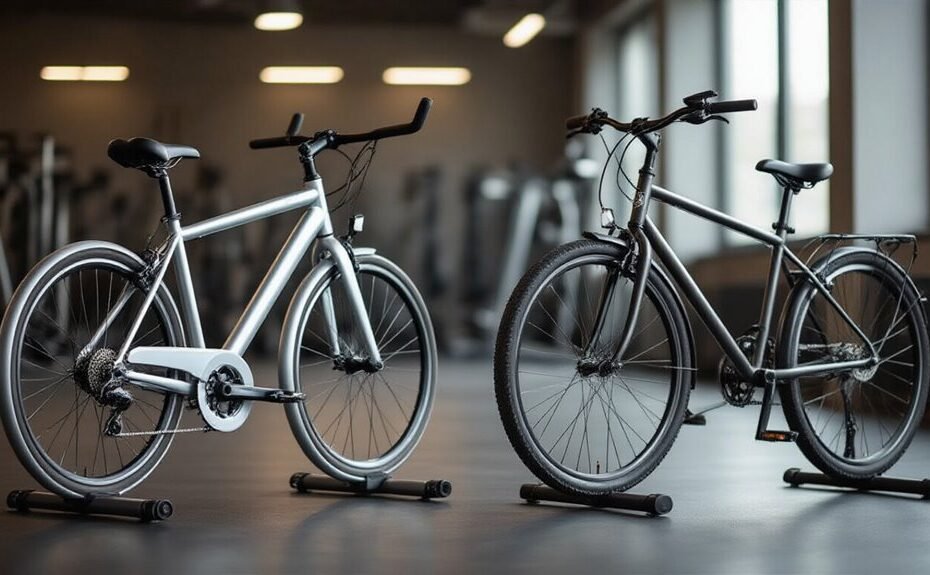The debate between aluminum and steel frames for indoor bikes isn’t just about weight. When investing in home fitness equipment, durability becomes paramount for long-term value. Steel frames typically outlast their aluminum counterparts under intense daily use, though they come with trade-offs in weight and sometimes price. Maintenance requirements differ greatly between these materials, especially when exposed to sweat and humidity. The right choice ultimately depends on usage patterns and expectations for longevity.
Some of the links in this article may be affiliate links. If you make a purchase through these links, we may earn a small commission at no extra cost to you. Thank you.
Material Properties: Steel Vs Aluminum for Static Bikes
When comparing the material properties of steel versus aluminum for indoor bikes, it is crucial to understand how each metal performs under the specific conditions of stationary cycling.
Steel frames boast superior tensile strength and fatigue limit, making them incredibly durable for high-traffic gym environments. While heavier (about 21 pounds), steel offers better shock absorption and is more repairable when damaged—it tends to bend rather than break.
Maintenance needs include rust prevention treatments.
In contrast, aluminum frames are lighter (approximately 19 pounds) but more susceptible to corrosion from sweat exposure. They’re less forgiving under stress and may develop cracks that limit their longevity in demanding settings.
Weight Distribution and Structural Stability
The structural foundation of any indoor bike directly impacts its performance during intense workout sessions. Steel frames, though slightly heavier at 21 pounds compared to aluminum’s 19 pounds, offer superior weight distribution that dampens vibrations and enhances comfort during rides.
While aluminum frames utilize larger diameter tubing, their structural integrity can be compromised under repetitive stress, making them more prone to cracking.
Steel frames, on the other hand, tend to bend rather than break under high loads, ensuring better long-term durability. This fundamental difference in material properties greatly affects ride quality, with steel providing more balanced feedback and stability during demanding workouts.
Sweat Resistance and Corrosion Prevention

Beyond structural properties, indoor cycling equipment faces another significant challenge: constant exposure to sweat.
Aluminum frames have a clear advantage here, featuring a natural oxide layer that provides excellent corrosion resistance with minimal maintenance.
Steel frames, while durable, demand regular rust prevention treatments to combat sweat damage.
In indoor use, aluminum’s longevity shines in humid environments.
Steel requires more vigilance—it can actually corrode from the inside out without obvious signs.
Regular inspections are essential, especially in sweat-prone areas.
For steel frame owners, protective measures like specialized anti-rust treatments and prompt cleaning after workouts are, well, non-negotiable for extending equipment life.
Load Capacity and Daily Gym Usage Impact
For commercial gym environments, load capacity emerges as perhaps the most critical factor when selecting between frame materials.
Steel frames outperform their aluminum counterparts due to their ability to flex rather than fracture under pressure. While aluminum frames are lighter, they’re more susceptible to developing cracks from repetitive impacts during daily gym usage.
The durability advantage of steel translates to a smoother ride as these frames better absorb vibrations. Though initially more expensive, steel frames typically require less frequent replacement, making them more economical long-term.
When maintenance issues arise, steel frames are generally easier to repair locally, extending their lifespan in high-traffic settings.
Long-Term Maintenance Requirements and Costs

Steel and aluminum indoor bikes present distinct maintenance challenges that impact their long-term ownership costs.
While steel frames require consistent rust prevention treatments and regular cleaning to combat sweat-induced corrosion, aluminum frames benefit from natural corrosion resistance but demand vigilant inspection for structural issues like cracks or paint bubbles.
The repair-versus-replace dynamic ultimately shapes the cost equation, as steel frames can often be welded and restored when damaged, whereas aluminum frames typically need complete replacement when compromised, potentially making steel more economical for facilities with repair capabilities.
Maintenance Cost Comparison
When considering the long-term financial impact of indoor bike ownership, maintenance costs can greatly influence the overall value proposition of aluminum versus steel frames.
While steel frames require consistent rust prevention treatments, they often prove more economical over time as repairs can be addressed through welding, extending their longevity considerably.
Aluminum frames, though corrosion-resistant, typically demand frequent inspections for signs of fatigue failure and sweat damage.
When aluminum deteriorates, replacement rather than repair is usually necessary—an expense that adds up.
The upfront investment in quality steel frames may seem higher initially, but the reduced maintenance costs and longer lifespan often deliver superior value compared to their aluminum counterparts.
Repair Frequency Analysis
Frequently overlooked in purchasing decisions, repair frequency presents a critical differentiator between aluminum and steel indoor bikes over their usable lifespans.
Steel frames consistently demonstrate superior longevity, requiring repairs far less often due to their weldable nature and resistance to fatigue. In contrast, aluminum frames, while lighter, typically develop cracks and corrosion issues more quickly, especially from sweat damage.
Though steel’s initial manufacturing costs may be higher, this investment pays dividends through extended durability. The maintenance equation isn’t just about routine care—it’s about how often you’ll face significant repairs.
For many riders, steel’s reliability outweighs aluminum’s short-term cost advantages.
Corrosion Prevention Requirements
Corrosion presents one of the most significant long-term challenges for indoor bike owners, directly impacting both maintenance requirements and ownership costs.
Steel frames demand vigilant rust prevention protocols, including regular cleaning and protective treatments to maintain structural integrity.
Aluminum frames, while naturally corrosion-resistant thanks to their oxide layer, aren’t completely maintenance-free.
Both materials require different approaches to maximize lifespan and durability. Steel’s repairability through welding might offset its higher maintenance needs, while aluminum’s virtual sweat immunity comes with the trade-off of limited repair options.
Regular inspections are essential for both frame types to catch early signs of damage, ultimately determining the true cost of ownership over time.
Stress Points and Frame Lifespan Comparison

The structural integrity of a bike frame largely determines its overall lifespan, with steel and aluminum frames responding quite differently to the stresses of indoor cycling.
Steel frames excel in durability, offering superior load capacity and the ability to bend rather than break under stress. This flexibility allows steel to withstand repeated strain, while aluminum frames—though lighter—lack a fatigue limit and eventually develop cracks at stress points.
For indoor bikes, this difference is vital. Steel can be easily repaired through welding, extending its lifespan considerably. Aluminum repairs are often cost-prohibitive, making replacement necessary.
Regular inspections for corrosion in steel and fatigue cracks in aluminum are essential maintenance practices. Additionally, regularly wiping down the bike can help prevent corrosion and extend the life of both frame types.
Frequently Asked Questions
What Are the Disadvantages of Aluminum Bike Frames?
Aluminum frames suffer from fatigue issues, poor repairability, harsh ride quality, lower impact resistance, and limited aesthetic options, despite weight advantages and corrosion resistance. Their stiffness transfers vibrations, affecting comfort.
Is Aluminum or Steel Better for Biking?
A 2-pound weight difference exists between materials. Neither aluminum nor steel is definitively “better” – steel offers superior ride quality and frame flexibility while aluminum provides weight advantage, corrosion resistance, and lower cost.
What Is the Most Durable Bike Material?
Steel offers superior frame strength and repairability options compared to aluminum. While steel requires more maintenance needs for corrosion resistance, it provides better ride comfort and longevity despite weight comparison disadvantages.
Do Steel Bikes Last Longer?
Coincidentally, steel bikes do last longer. Their superior steel strength and frame resilience enable greater bike longevity, though maintenance requirements increase due to corrosion resistance concerns. The weight comparison favors aluminum, but repairability issues favor steel.
